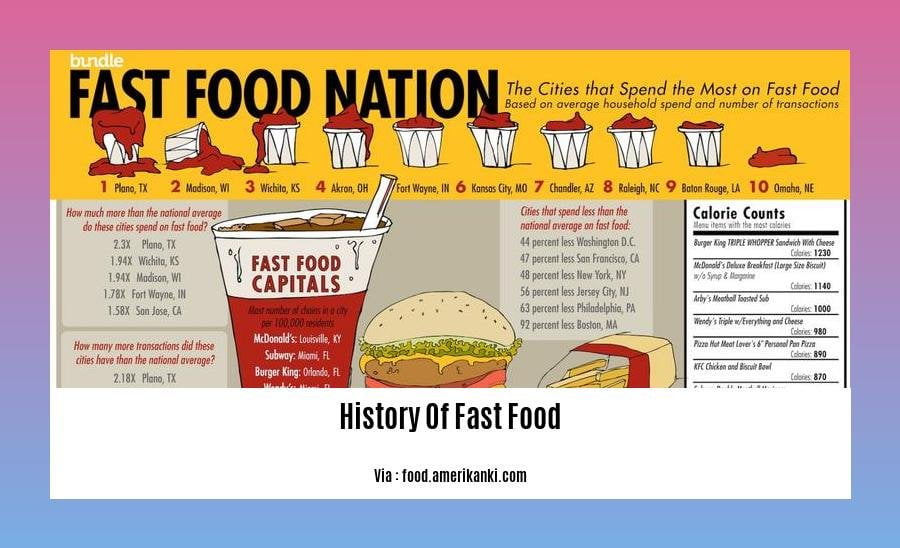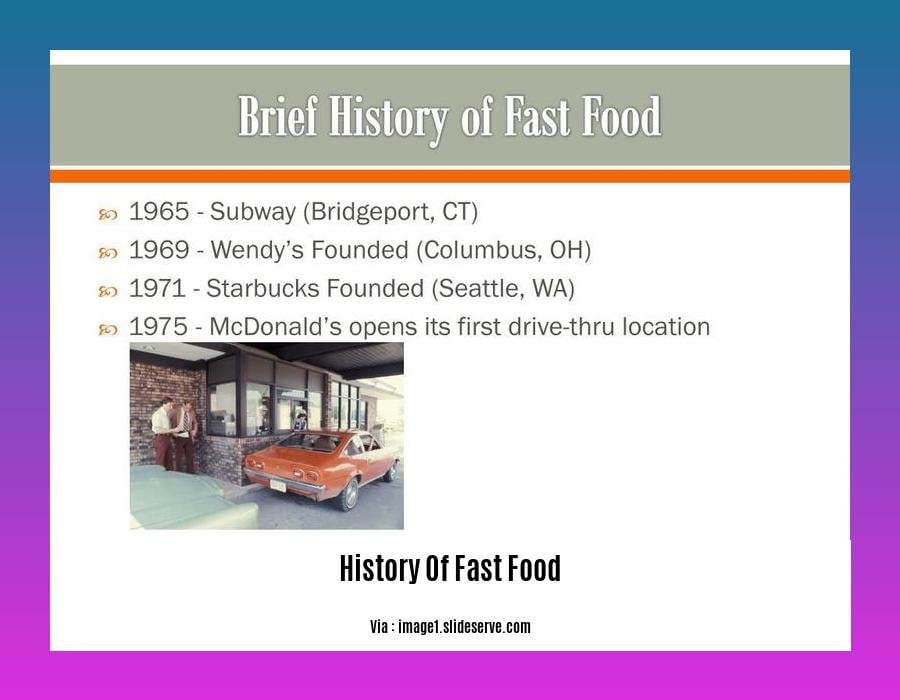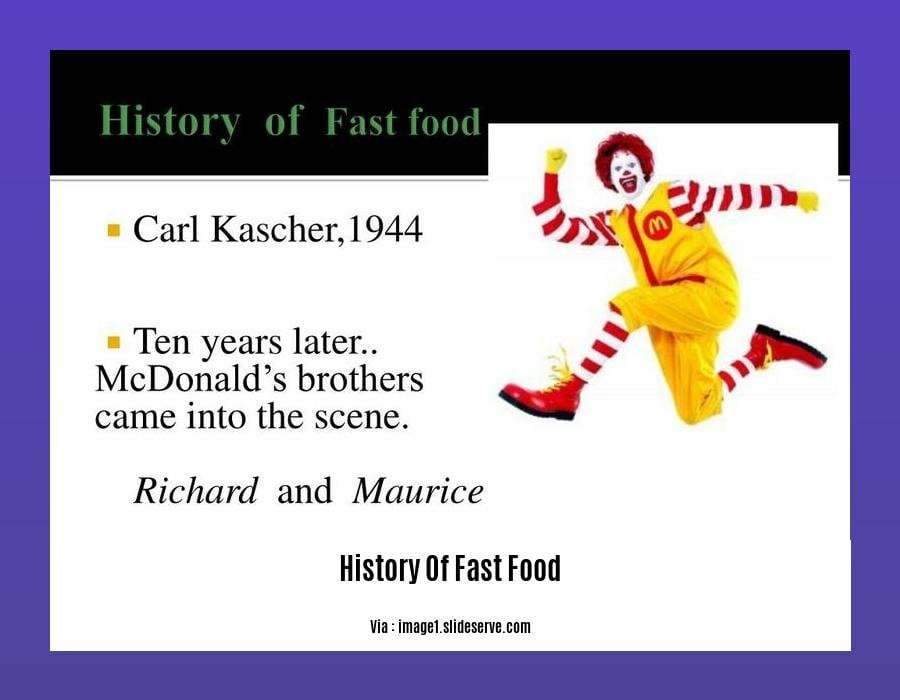2. Tracing the Evolution of Fast Food: A Historical Perspective
3. Fast Food’s Impact on Society: A Historical Exploration
4. The Cultural Significance of Fast Food: A Historical Analysis
5. Fast Food: A Culinary Phenomenon: A Historical Overview
6. The History of Fast Food: How We Got Here
7. Evolution of Fast Food: A Historical Timeline
8. Fast Food’s Journey: From Humble Roots to Global Dominance
9. The History of Fast Food: A Cultural and Culinary Exploration
10. Fast Food: A Historical Perspective on Our Culinary Landscape
Prepare to embark on a culinary journey through time as we delve into the history of fast food. From its humble beginnings to its global dominance, fast food has left an indelible mark on our culinary landscape. Get ready to explore the cultural, social, and economic factors that have shaped this ubiquitous phenomenon.
Key Takeaways:
Fast food history dates back to ancient times when street vendors sold ready-to-eat foods to city dwellers.
The first fast food restaurant, White Castle, was established in 1921, serving small hamburgers for 5 cents each.
Factors like urbanization, industrialization, and the rise of the automobile contributed to the popularity of fast food in the 20th century.
Fast food chains like McDonald’s, Burger King, and KFC revolutionized the way people ate in the latter half of the 20th century.
Fast food has been criticized for its negative health implications, leading to the growth of healthier fast food options and increased nutrition awareness.
History of Fast Food

Fast food, a ubiquitous culinary phenomenon, has its roots in antiquity. From ancient street vendors purveying ready-to-eat meals to bustling urban dwellers, the concept of quick and convenient food has endured for centuries.
The first fast food restaurant, White Castle, emerged in Wichita, Kansas, in 1921, pioneering the concept of small hamburgers sold for a mere 5 cents each. This brainchild of Walter Anderson and Billy Ingram revolutionized the dining landscape, setting the stage for the fast food empire we know today.
The 20th century witnessed a surge in fast food’s popularity, driven by urbanization, industrialization, and the advent of the automobile. The demand for quick and portable meals soared as people embraced a fast-paced lifestyle.
The latter half of the 20th century ushered in an era of unprecedented growth for the fast food industry. Fast food chains like McDonald’s, Burger King, and KFC emerged, transforming the way people ate. These culinary giants standardized menus, streamlined operations, and introduced innovative marketing strategies, propelling fast food into the global culinary lexicon.
However, the meteoric rise of fast food was not without its drawbacks. Concerns about its negative health implications gained traction, leading to the rise of healthier fast food options and increased consumer awareness of nutrition.
Fast food’s journey through time is a tale of innovation, convenience, and cultural impact. From its humble beginnings to its current global dominance, fast food has left an indelible mark on our culinary landscape, shaping our eating habits and influencing our cultural norms.
Do you want to learn how the shimmering Christmas lights that brighten the holiday season came to be? Check out this fascinating account of the history of Christmas lights to find out.
Dive into the evolution of Christmas ornamentation and discover the enchanting stories behind those beloved Christmas ornaments that adorn your tree.
Unravel the intriguing history of Christmas wreaths and uncover the symbolism and traditions that have made them an iconic symbol of the festive season.
Cultural influences and regional variations: exploring how diverse cuisines and cultural preferences have shaped the global landscape of fast food

Fast food is a global phenomenon that has been shaped by a multitude of cultural influences and regional variations. From the humble beginnings of street vendors to the global dominance of fast-food chains, the evolution of fast food has been influenced by a complex interplay of geography, history, and culture.
In many cultures, food is deeply intertwined with cultural identity and heritage. Regional cuisines often reflect the unique flavors, ingredients, and cooking techniques of a particular area, and fast food is no exception. In countries like Japan, for example, fast-food restaurants often offer dishes that are inspired by traditional Japanese cuisine, such as ramen, sushi, and tempura.
The globalization of fast food has led to the spread of these regional cuisines around the world, creating a diverse and vibrant culinary landscape. In cities around the world, it is now possible to find fast food restaurants serving everything from tacos and burritos to pad thai and samosas.
The cultural significance of fast food goes beyond its role as a culinary offering. For many people, fast food is associated with convenience, affordability, and a sense of nostalgia. Whether it’s a quick bite to eat between errands or a comforting reminder of childhood, fast food has become an integral part of our daily lives.
Key Takeaways:
- Fast food has been shaped by a multitude of cultural influences and regional variations.
- Cultural identity and heritage are often reflected in the flavors, ingredients, and cooking techniques of fast food.
- Globalization has led to the spread of regional cuisines around the world, creating a diverse culinary landscape.
- Fast food is significant not only as a culinary offering but also as a symbol of convenience, affordability, and nostalgia.
Sources:
- Exploring Food Culture: How Cuisines Reflect Cultural Identity
- Food: Identity of Culture and Religion
Health and Sustainability Considerations: Discussing the Growing Emphasis on Healthier Options and the Environmental Impact of Fast Food Practices
In the realm of fast food, a paradigm shift is underway. Consumers are increasingly demanding healthier options, and sustainability concerns are taking center stage. This section delves into these critical considerations, exploring the evolving landscape of fast food.
A Healthier Fast Food Future
Gone are the days when fast food was synonymous with greasy burgers and sugary sodas. Today’s consumers seek healthier choices that align with their well-being goals. Fast food chains are responding by introducing healthier menu options, such as grilled chicken sandwiches, salads, and fresh fruit.
Environmental Responsibility
The environmental impact of fast food practices is another pressing concern. From packaging waste to carbon emissions, the industry has a significant footprint. Recognizing this, many fast food chains are implementing sustainable initiatives, such as using biodegradable packaging, reducing energy consumption, and sourcing ingredients from sustainable sources.
Key Takeaways:
- Consumers are demanding healthier fast food options.
- Fast food chains are responding with healthier menu items.
- The environmental impact of fast food practices is a growing concern.
- Fast food chains are implementing sustainable initiatives.
Citations:
- Wiley Online Library: Healthier and more sustainable diets: What changes are needed in food production and consumption?
- SAGE Journals: The Role of Healthy Diets in Environmentally Sustainable Food Systems
Future of fast food: speculating on potential trends and innovations shaping the industry, such as automation, personalization, and alternative protein sources
Fast food, a cornerstone of modern society, has undergone a remarkable evolution over the years, mirroring societal shifts and technological advancements. As we look ahead, the trajectory of fast food continues to intrigue experts and foodies alike. In this article, we’ll delve into potential trends and innovations that could profoundly reshape the fast-food landscape.
Key Takeaways:
Automation and AI are poised to revolutionize fast-food operations, enhancing efficiency, accuracy, and consistency.
Personalization will take center stage, with customers empowered to customize their meals according to their unique preferences.
Alternative protein sources, such as plant-based and insect-based options, will gain traction as consumers become more health and environmentally conscious.
The metaverse and virtual reality will redefine customer experiences, offering immersive dining encounters.
Sustainability will become a key driver, with fast-food chains exploring eco-friendly packaging, reducing food waste, and implementing sustainable sourcing practices.
Automation and AI: Efficiency Reimagined
Automation and artificial intelligence (AI) are poised to revolutionize fast-food operations, bringing forth a wave of efficiency, accuracy, and consistency. From self-service kiosks to AI-powered drive-thrus, technology will streamline the ordering process, minimize wait times, and improve overall customer satisfaction.
Personalization: Empowering Customer Choice
In the era of personalization, fast-food chains will embrace customization like never before. Customers will have the power to tailor their meals to suit their dietary preferences, allergies, and personal tastes. Interactive menus, dietary recommendations, and personalized offers will elevate the fast-food experience, transforming it into a truly bespoke affair.
Alternative Proteins: A Healthier, Greener Future
The demand for healthier and more sustainable food options is on the rise, and fast-food chains are taking notice. Alternative protein sources, such as plant-based and insect-based options, will gain traction as consumers become more conscious of their health and the environment. These innovative ingredients offer a nutritious and environmentally friendly alternative to traditional meat, paving the way for a healthier fast-food landscape.
Metaverse and Virtual Reality: A New Dining Frontier
The metaverse and virtual reality (VR) are poised to redefine customer experiences in the fast-food industry. Imagine stepping into a virtual restaurant, customizing your meal in real-time, and immersing yourself in a multisensory dining experience. VR technology will revolutionize the way we interact with fast food, creating a whole new realm of possibilities.
Sustainability: A Path to a Greener Future
Sustainability will become a key driver in the fast-food industry, as consumers become increasingly concerned about the environmental impact of their food choices. Fast-food chains will explore eco-friendly packaging, reduce food waste, and implement sustainable sourcing practices to align with consumer values and create a more sustainable future.
As the fast-food industry hurtles towards the future, its trajectory is shaped by a convergence of innovation, personalization, and sustainability. These trends and innovations promise to revolutionize the way we experience and interact with fast food, creating a more efficient, healthier, and sustainable dining experience for generations to come.
Relevant URL Sources
[1] https://www.cbinsights.com/research/report/future-of-fast-food
[2]















